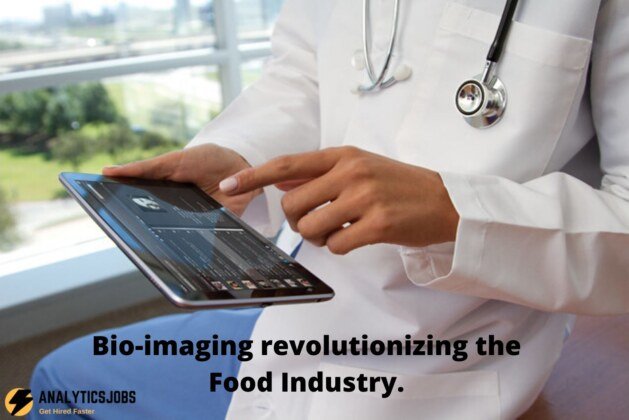Food security is now 1 of the top priorities around the globe and the importance is well understood by everybody active in the food supply chain and consumers, retailers, transporters, processors, and producers. Food safety requirements are regularly reviewed worldwide to take the safety and keep the quality of agricultural items and prepared foods supplied to the customers. As protection requirements are raised, conservative technologies can’t sustain the requirements and hence pave the means for completely new technologies such as for instance bio-imaging in the food business.
Introduction of bio-imaging.
Digital image processing started in the 1960s for space apps and the early 1970s for health programs, remote sensing, and astronomy. Research fascination with image processing with the food and agriculture industry started in the late 1970s and some of the real-time applications had been created in the years of the 1980s and 1990s. Scientists recognized the possibility of image processing and then started focusing on research in the food industry.
Definition
Biological imaging or bio-imaging is a computer vision technology that uses artificial vision rather compared to human vision to observe, capture, progression and provide an item of interest. Researchers in the food and farming industry have explored the options of using thermal, infrared, MRI, and X-ray imaging.
Its Components
Bio-imaging systems include the fundamental components such as camera, frame grabber, illumination, and image processing hardware, and software.
A camera is a main component which captures the picture of the content of interest. You will see a variety of sensors used, of those sensors, a charge-coupled device video camera the most widely used for evaluating external qualities for example color, shape, specifications, and area texture. For evaluating internal quality attributes, sophisticated image acquisition sensors, like MRI and X-ray are used. Illumination is the lighting source and it is really important in taking good quality pictures. The frame grabber is a unit which aids in the transformation of this analog video signal in the digital camera right into a digital signal. Image processing hardware runs arithmetic and reasonable operations, and software allows people to create codes to evaluate the captured images.
Stages in bio-image processing
Bio-image processing involves simple steps including image acquisition, pre-processing, development, segmentation, representation, recognition, and description. Image acquisition is the procedure of obtaining the raw binary data from the image of interest. Pre-processing is the procedure of decreasing the unwanted features in the pictures. Enhancement is the method of making the picture more clear and highlighting the area of interest.
Segmentation is definitely the procedure of dividing the image into parts. Segmentation is implemented by representation in which data is represented as a whole region or a boundary based on whether the goal is focusing on the external shape attributes or the inner features. The explanation is definitely the method of obtaining useful quantitative data from the image features. Image recognition is the procedure of determining an item based mostly on its description.
Why is bio-imaging required?
Quality is the most crucial aspect of the food market since the last product is directly connected to the health and well-being of the customer. The demand for bio-imaging became significant as expectation and awareness among customers increased regarding the security aspects of food products. A lot of the quality monitoring operations in the food industry are done by human inspection, and that is sometimes less accurate results, subjective, inconsistent, tedious, and labor-intensive creates. Image processing techniques are non-destructive, consistent, and rapid for the quality evaluation of different food items.
Imaging techniques
- X-ray Imaging replaced metal detectors as an ability to identify metal or thin solutions in the assortment of 0.5 to 0.7 mm and glass contaminants in the assortment of 1.5-3mm. Because it’s depending on the density of the products, it’s possible to identify any contaminants in food. Metal detectors can’t be useful for items packed in metalized aluminum trays, foils, or films, whereas X-ray systems may be used for all kinds of product packaging. X-ray imaging isn’t just used to identify product contamination, though it is able to also find missing or broken items, monitor fill amounts, and identify improperly sealed packages.
- Magnetic Resonance Imaging offers information that is useful on inner tasks such as oil and moisture distribution, crystallization of frozen meal, fermentation monitoring in dairy and beer products. MRI is helpful to monitor and give inner qualities of fresh fruits and vegetables such as bruising, cracks inside apples, tomatoes, and also potatoes.
- Infrared Imaging is a non-contact, non-destructive method which allows for online testing during production and provides valuable data without impeding efficiency and consuming time.
- Thermal Imaging is utilized in the food industry for non-contact temperature measurement of food. Temperature is a crucial parameter and an increase or decrease in it might decrease the shelf-life of products or in the progress of microorganisms, and that makes them product unsafe for consumption. Thermal imaging has different uses such as monitoring the heat of proper filling and various products of frozen meals.
Food applications using Biological imaging.
- Meat and poultry
- The uses of MRI in the various meats industry are the estimation of poultry breast-meats yield, perseverance of various meal pieces including fat content and water in ground beef, high fat deboned chicken, and fresh pork, measurement of lean beef portion of a pig carcass. Thermal imaging is utilized for determining the body fat content of ham and pork. MRI can be used to figure out the caliber of eggs to discover defects like blood spots, dirt spots, and cracks in eggs.
- Fruits and vegetables
- X-ray imaging is used for distinction of normal peaches and split-pit and detection of insect harm in mangoes, bruises, and water center of apples, defects in onions. MRI might be used for the detection of primary description in pears, sensory of tomato maturity measurement and evaluation of potatoes. Thermal imaging may be utilized to monitor and evaluate the surface area drying period of citrus fruits. Optical imaging is used for grading fresh fruits and vegetables including onions, tomatoes, potatoes, strawberries, mandarins, apples, and peaches.
- Packaged foods
- Detecting spoilage in packed food is a significant challenge for the food industry since they demand damaging testing of the sample and time-consuming procedures. MRI might be used to examine food quality because the primary sign of food spoilage is a lowered ph. MRI is used for detecting bacterial pollution in soy sauce, cheese, and milk. Optical coherence tomography might be used for online analysis and quality control of multi-layered foils used in food packaging.
- Grains
- X-ray imaging is used to detect insect infestation, distinction of vitreousness, detection of fungal infections in wheat. MRI might be used for the measurement of this modification of moisture profile and to learn the structural changes in rice during cooking by overseeing the water division. Thermal imaging was put to use for the detection of insect infestation of grain and sprout harm in wheat.
- Confectionery
- The three-dimensional cellular microstructure of food like chocolate, marshmallows, and muffins was analyzed using X-ray imaging. MRI might be used in order to notice moisture migration in confectioneries and to learn the rehydration qualities of extruded pasta.
- Nuts
- X-ray imaging is used for the detection of international bodies in hazelnuts. The presence of unwanted overseas components like stones, cardboard of almonds, and metal chips, chestnuts, and also raisins was recognized using thermal imaging.
Conclusion
X-ray imaging has swapped out metal detectors for dedication of bodily contamination in fresh fruits & vegetables, prepared and packaged foods, fish, meat, grains, and dairy. Thermal imaging found uses in the heat mapping of food to detect contamination and spoilage. MRI is used for the determination of moisture content migration and liquid distribution in the food items. It’s apparent that soon bio-imaging is going to play a crucial role in the food industries.



